Our cattery works with traditional tabby colors. We think that tabby colored cats looks like forest cats. They are most spectacular and most distinctive. They have so beautyful eyes circled with black stripes, stripes, which emphasize high cheekbones, dark ear tipping. Dark stripes on the forelegs and circles on the tail make them perfectly similar to tigers. We have different colors in our cattery: very usual black tabby cats, silver tabbies, which look like snow leopard or an arctic fox, and even most rare and beautyful golden tabbies.
The variety of colors of Siberian cats is probably one of the most attractive features, which evokes interest towards this breed. According to WCF standard, all colours are acceptable for Siberian cats, except chocolate, tabby, their derived shades, and Abyssinian tabby.
No doubt that the typical color, common in our country, is Siberian brown tabby.
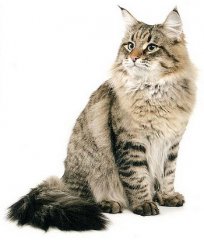 It is on this color that the first clubs concentrated their efforts to stabilize the breed. For example, during the first years of work, the «Fauna» club admitted for breeding only brown tabby, brown tabby with white and brown torby. Such practice proved evidently effective: the offspring of the animals, outbred in «Fauna» (breeding catteries «Yahont», «Seliger»), still successfully «hold the breed». It is advisable that current breeders constantly keep in mind holding the breed and, from time to time, using strong animals with «wild» color for mating. Therefore, I recommend to refer to Irina Shustrova’s article of the magazine «Friend», issue 8-9 (2003), called «The stability of breeds».
It is on this color that the first clubs concentrated their efforts to stabilize the breed. For example, during the first years of work, the «Fauna» club admitted for breeding only brown tabby, brown tabby with white and brown torby. Such practice proved evidently effective: the offspring of the animals, outbred in «Fauna» (breeding catteries «Yahont», «Seliger»), still successfully «hold the breed». It is advisable that current breeders constantly keep in mind holding the breed and, from time to time, using strong animals with «wild» color for mating. Therefore, I recommend to refer to Irina Shustrova’s article of the magazine «Friend», issue 8-9 (2003), called «The stability of breeds».
According toFIFEand WCF classifications of colors, the designation of brown tabby is SIB n 23, which is also referred to in various organizations as «brown mackerel tabby», «black mackerel tabby» or, briefly, «brown tabby» or «black tabby». Despite the confusing use of the word «brown» in the name of this color, it has nothing to do with the chocolate color, which actually looks brown.
The brown tabby has the dominant allele B (black). The darkest shade in the color is actually black: the tip of the tail, the stripes on the legs, back and sides. The background color in the interims between the stripes can be grey, grayish brown and sometimes even warm orange. The shade of the underfur is not standardized for this color, but the main requirement is regularity of stripes (classic «M» on the forehead, a stripe on the back, two long stripes on the sides, parallel to the one on the back, continuous «gorgets» on the neck, thin and clearly marked continuous stripes from the back to the stomach, two rows of «buttons» of the main shade on the stomach) and clarity of color, its «differentiation» from the background. Brown tabby Siberian cats are very distinctive: they have charming eyes, the shape of which is emphasized by the light eyeliner around them, fantastic velvet black paws, raccoon-like tail and black locks of hair on their ears. Their eyes may be of regular yellow or green color, but the «wild» green is, of course, more impressive.
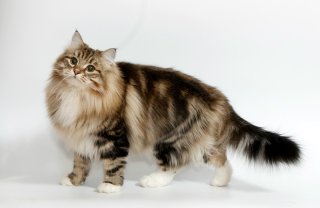 The marble color is less common. In the ems code system its designation is SIB n 22. Other names: brown classic tabby, black classic tabby. Marble cats have an «M» letter on the forehead, two long stripes on the sides, parallel to the one on the back, continuous «gorgets» on the neck, «butterflies» on the shoulders, beautiful wide circles on the sides and two rows of «buttons» of the basic shade on the stomach. It is very difficult to achieve clear and bright color pattern on rather long fur of Siberian cats, but animals with regular marble color look very spectacular and impress judges on the exhibitions.
The marble color is less common. In the ems code system its designation is SIB n 22. Other names: brown classic tabby, black classic tabby. Marble cats have an «M» letter on the forehead, two long stripes on the sides, parallel to the one on the back, continuous «gorgets» on the neck, «butterflies» on the shoulders, beautiful wide circles on the sides and two rows of «buttons» of the basic shade on the stomach. It is very difficult to achieve clear and bright color pattern on rather long fur of Siberian cats, but animals with regular marble color look very spectacular and impress judges on the exhibitions.
Sometimes the third variety of tabby can be observed in Siberian cats: black spotted color. It is designated as SIB n 24, brown spotted, black spotted. In general, it resembles brown tabby, but, unlike it, black spotted animals should have clearly defined spots on the sides. It is curious that we can observe another spectacular variety of spotted color in Siberian cats, a so-called «spotted marble»: large spots on the sides, sometimes resembling «rosettes» with a lighter center, like in breeds selected on the basis of wild animals, such asBengalcats.
It is often possible to observe Siberian striped cats at exhibitions, which confuse the judges and evoke a lot of disputes as to the acceptability of their color, and the correct designation for them (should they be classified as SIB n 21, or still as SIB n 24 or 23): the cat looks as a typical cat with Agouti factor: the letter «M» on the forehead, «buttons» on the stomach, stripes on the paws and tail, but (!) no stripes on the body. We can be sure that such color in Siberian cats has nothing to do with Abyssinian tabby, since after numerous crossings among such animals the stripes do not disappear for many generations, and the color is regularly inherited. It is well-known that such color is very common in the breed and possibly is the «wildest», original, variety of tabby in Siberian cats. On the contrary to Abyssinian tabby, it can be encountered in other breeds. Unfortunately, the genetic origin of this color, as well as spotted color, is still unknown.
Finally, let us proceed from the striped tabby to chinchilla colors, which are also striped from the genetic point of view, i.e. they are based on the «Agouti» gene. On the contrary to the tiger, marble, spotted and «wild tabby», the hairs of chinchilla cats have only two stripes (!) all over the body: a light stripe near the root of the hair and a dark stripe at the tip. Chinchilla cats look like very light with no stripes, only with a slight veil of the basic color. The standard defines two varieties of chinchillas: shaded, with darker color, and veiled. It is extremely difficult to find Siberian cats, which can be assuredly designated not to the above mentioned «common tabby», but specifically to chinchillas. Of course, this does not mean that I will insist that Siberian chinchillas do not exist and cannot exist at all.
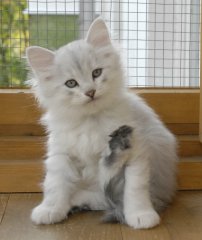 Once we started discussing chinchillas, it is relevant to mention the «precious» gold and silver. The situation is a little simpler with silver colors than with golden ones. For the sake of simplicity, we can assume that this color is produced by melanin inhibitor gene I. The recessive allele of this gene does not produce a notable influence on the color, but the dominant one stops the synthesis of the melanin pigment, and because of this only the upper part of the guard hairs is colored, but the lower part of the guard hairs and the underfur remain white. All varieties of tabby cats result from this influence: tiger, marble, spotted, «common tabby», chinchilla silver.
Once we started discussing chinchillas, it is relevant to mention the «precious» gold and silver. The situation is a little simpler with silver colors than with golden ones. For the sake of simplicity, we can assume that this color is produced by melanin inhibitor gene I. The recessive allele of this gene does not produce a notable influence on the color, but the dominant one stops the synthesis of the melanin pigment, and because of this only the upper part of the guard hairs is colored, but the lower part of the guard hairs and the underfur remain white. All varieties of tabby cats result from this influence: tiger, marble, spotted, «common tabby», chinchilla silver.
The genetic origin of the golden color is currently being studied. The main sign of this color: in golden tabby, more than 1/2 of the guard hairs are colored warm apricot, in golden shaded chinchillas — up to 2/3, and in golden chinchillas — 7/8. Bright green, and sometimes blue-green, outlined and expressive eyes of these cats, the warmth of their color, dark velvet paws, emphasized against the background of the bright yellow legs and panties, have evoked significant interest and even excitement. Unfortunately, this color is very difficult to work with, and does not yield quick success, requiring tedious work, especially if you want to maintain the heavy, strong breed. This is why there are few good animals in this color pattern, and it is difficult to expect a lot of outstanding representatives of this color.
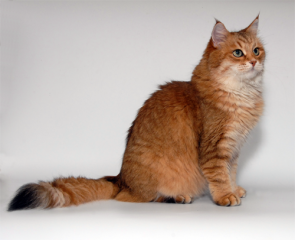
Golden Siberian cats have become so bright that non-experts in colors sometimes even confuse them with «red» ones, but any breeder knows that «red» color (or «flame») is defined by a completely different gene. This O-gene (orange) is sex-related, i.e. located in the sex chromosome. I will not dwell upon the details of genetics, please refer to the mentioned link, if interested. I will only say that, due to this peculiarity, male cats are usually black or red, but females can be black and red at the same time, i.e. torty.
The torties are a treasure for the cattery. It is impossible to get such a variety of litter colors from a cat of any other color.
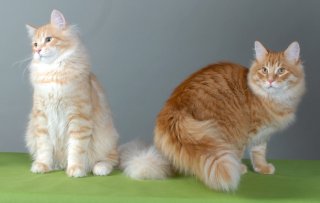 Another peculiarity of the red shades is that a color pattern is often preserved on their background in the absence of Agouti-factor. This means that it is very difficult to decide if the animal is red tabby or red without tabby. This can be established either by studying the breeding record of the animal, or the offspring from its matings.
Another peculiarity of the red shades is that a color pattern is often preserved on their background in the absence of Agouti-factor. This means that it is very difficult to decide if the animal is red tabby or red without tabby. This can be established either by studying the breeding record of the animal, or the offspring from its matings.
The red Siberian cats, on the contrary to other colors, often have dark orange eyes, which many judges already began to consider as undesirable feature for other colors.
There are lighter shades correspondent to each of the above mentioned breeds, which only differ in one gene: D (dilutor). Due to its mutant recessive allele we receive:
from brown tabby — blue tabby,
from black marble — blue marble,
from black spotted — blue spotted,
from black silver marble — blue silver marble,
from black chinchilla — blue chinchilla,
from red tiger — cream tiger etc.
And finally, in the absence of dominant Agouti, we will see evenly colored animals: plain black, blue and torty. These colors of Siberian cats look good also: raven black with green eyes, or light-blue eyes with silver tinge…
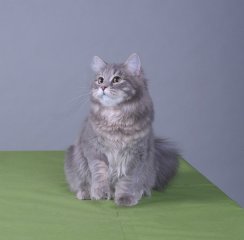
Judges especially appreciate even colored species with no grey hairs and grey-brown shades. However, the color of young animals can be evolving for a long time, this is why you should not be upset and sort out a black Siberian younger than 18 months.
An interesting color can be received by the combination of the recessive «without Agouti» gene and silver. Such colors are called smokes. Depending on the basic color, we can receive: black smoke, blue smoke, red smoke, smoke torty. In case of an ideal color, animals can look almost self-colored, but, looking deeper into the fur, we could see a snow white underfur. The more marked the contrast, the better. Among the defects of color, we could mention irregular intensity of «smoke» on various parts of the body and signs of shadow tabby. The color evolves for a ling time, sometimes only by the age of 3 years.
According to the standard of Siberian breed, any amount of white is admitted and a combination of spots with any basic color. The animal can have small white spots, e.g., on the chest; it can be a classic bicolor with some white on the snout, white chest, stomach and legs; it can be harlequin and even van.
Unfortunately, relatively few breeders in our country work with the white color. Classic bicolors of any color: brown classic with white, torty with white, red tiger with white, silver tiger with white etc. – look extremely spectacular if the white is symmetrical, but this is very difficult to achieve, and a long tedious selection of parents is necessary. In my opinion, the so-called calico color is especially beautiful.
From the genetic point of view, another interesting point is white color. There are two types of white color in Siberian cats, based on two completely different genes. In the first case it is caused by white masking gene W, in the second case — recessive allele ofAngoraalbino. With white masking gene, it is rather easy to breed white animals, since you can obtain white litter after mating with a parent of any color. If W gene has been inherited from at least one parent, the kitten will be white.
With the recessive white, the offspring will be white only after mating with animals, possessing the W-gene, or if the rare recessive angora albino gene has been inherited from both parents. It is by this gene that the color of the female cat Odelina-Philippa has been produced (Sargy cattery, owner Doroshenko Y.S.). Pay attention to the extraordinary color of the eyes of this cat — pinkish blue. It should be noted that white cats with W allele can have blue, yellow and green eyes, and even eyes of different color: one yellow, and one — blue. Unfortunately, the blue color of the eyes of these cats can be associated with one unpleasant defect — deafness. Animals for exhibitions must have normal hearing. The requirements to the white color are the same as to the other plain colors: animals must have even bright white color all over the body with no spots and shades. Young animals sometimes have small spots that disappear with age.
A lot of controversy has been caused by the color-point. Does it have to be considered as Siberian breed, or should it be separated in a different Neva Masquerade breed… I can only point out that if the breeders want to maintain the original breed, close to fully-colored Siberian species, they should necessarily cross color-points with animals of traditional color.
It is impossible to deny that color-point Siberian cats are very popular. The additional requirements to the cats of this color, usually set at the exhibitions (all other things being equal) — regular color of the points, the points should be detached from the general color of the body, even color of the points: it is very desirable that the points should have the same color intensity both on the paws and the snout, preferably with no spots on the stomach. Darker animals can lose part of the points for the color.
It should be noted that, according to the modern WCF standards, Siberian cats can have rather exotic colors and combinations of fur color and eye color, which are not accepted in other breeds: cream silver color-point with white, golden tabby color-point, black smoke with white spot with green eyes.